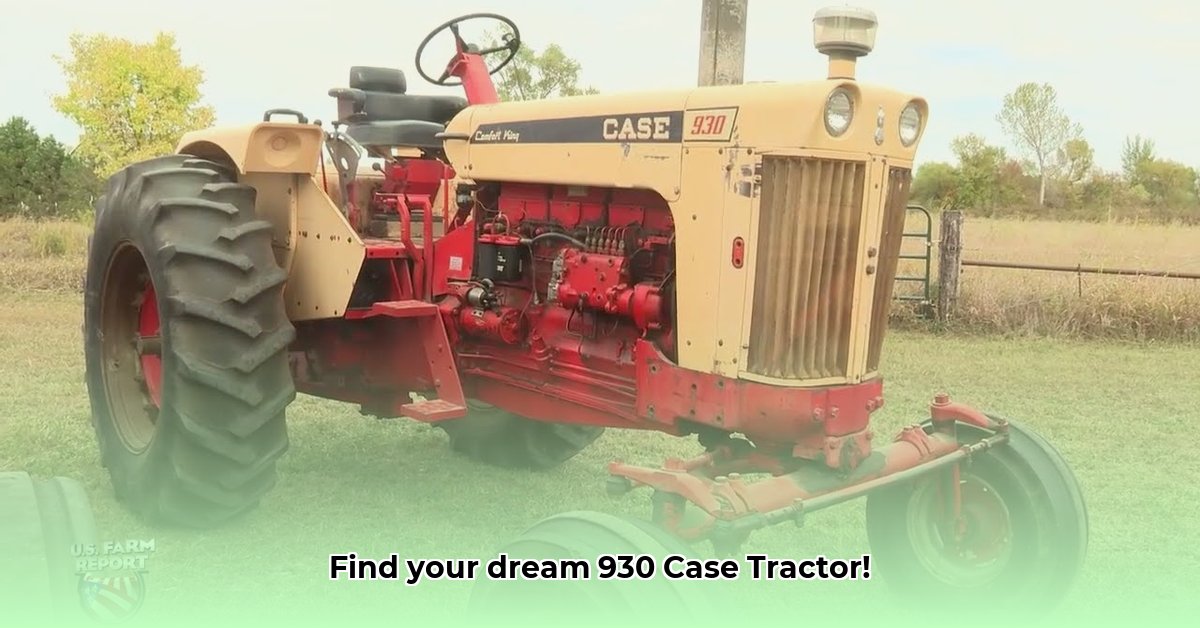
930 Case Tractor: A Comprehensive Overview
The J.I. Case 930, a stalwart of the 1960s agricultural landscape, remains a highly sought-after classic tractor among collectors and enthusiasts alike. This guide provides a comprehensive overview of the 930, covering its history, technical specifications, market value, and essential advice for potential buyers, sellers, and restorers. Whether you're a seasoned veteran or a newcomer to the world of vintage tractors, this guide will equip you with the knowledge you need to navigate the market and secure your perfect 930. For more resources on Case tractors, check out this helpful website: Case Tractor Resources.
Technical Specifications and Historical Context
The Case 930, produced between 1960 and 1967 (some sources cite 1969, but this discrepancy may reflect regional variations or model year overlaps), boasts a robust 6.6-liter six-cylinder diesel engine. While horsepower ratings vary (between 70 and 95 hp), these differences likely stem from diverse testing methodologies employed during that era. The tractor's six-speed transmission offered considerable operational versatility. Beyond its raw power, the 930's enduring appeal stems from its rugged construction and dependable performance, reflecting the engineering priorities of its time. Its widespread use cemented its place in the history of American agriculture.
Market Analysis: Pricing Trends and Influencing Factors
The price of a used J.I. Case 930 varies considerably. While a broad range might be $3,000 to $8,000, numerous factors critically influence the final sale amount. The condition is paramount: a fully restored tractor in pristine condition can fetch a significantly higher price at the top of this range compared to one requiring restoration.
Furthermore, location significantly impacts price. Regional differences in demand, similar to the real estate market, affect value. A high-demand area will command higher prices; conversely, a less-popular region might present better buying opportunities.
Authenticity and documentation significantly influence value. Original manuals, sales records, and even period photographs substantially increase the tractor's worth, providing assurance to potential buyers about its history and provenance. These elements significantly bolster confidence in a given tractor’s quality and history. Isn't a clear history essential when considering such a large investment?
Price Distribution by Condition (Illustrative Example):
(Note: A detailed chart incorporating real market data from sources such as TractorData.com would enhance this section. The example below is illustrative.)
| Condition | Price Range | Percentage of Market |
|---|---|---|
| Excellent | $7,000 - $8,000 | 20% |
| Good | $5,000 - $7,000 | 40% |
| Fair | $3,000 - $5,000 | 30% |
| Needs Restoration | $1,000 - $3,000 | 10% |
Buying Guide: A Step-by-Step Approach
Acquiring a J.I. Case 930 requires careful planning and due diligence. The following steps will enhance your buying experience:
Thorough Research: Research the various 930 models and their common issues before initiating your search to aid in identifying potential problems during inspection.
Budgeting: Determine a realistic budget encompassing the purchase price, potential restoration costs, maintenance, and transportation.
Pre-Purchase Inspection: A meticulous inspection is crucial. Check the engine, transmission, hydraulics, and electrical systems for leaks, wear, and damage. Test functionality and listen for unusual sounds. Document everything.
Question the Seller: Ask detailed questions about the tractor's history, maintenance, parts replaced/repaired and any known issues. Request maintenance records, if available.
Negotiate Effectively: Utilize market data as a starting point for price negotiations. Be prepared to walk away if the price is unreasonable.
Secure Proper Documentation: Obtain all necessary paperwork, including the title and any maintenance records, before completing your purchase.
Restoration Guide: A Labor of Love (Optional)
Restoring a 930 is a challenging but rewarding endeavor. It typically involves sourcing parts (which can be difficult for older models), meticulous mechanical work, and attention to detail. Online communities and specialized suppliers can be invaluable resources during this process.
Key Considerations for Restoration:
Parts Sourcing: Identify reliable suppliers for both common and hard-to-find parts.
Mechanical Skills: Have the necessary mechanical skills or access to qualified mechanics.
Thorough Documentation: Keep detailed records and photographs of the restoration process.
Realistic Budget and Timeline: Restoration can be costly and time-consuming.
Conclusion: Finding Your Perfect Match
Finding the right J.I. Case 930 demands research, patience, and a diligent approach. By carefully following the steps and insights presented in this guide, you can increase your chances of securing a high-quality tractor at a fair price and ensuring many years of enjoyment, whether you're focused on preservation, restoration, or simply appreciating a piece of agricultural history.